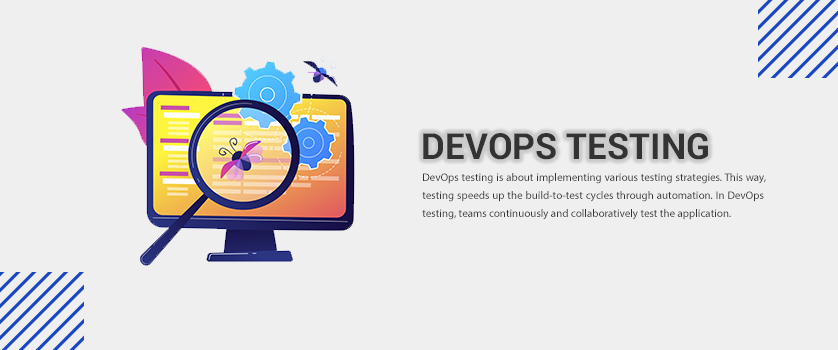
What is DevOps Testing?
DevOps testing is about implementing various testing
strategies. This way, testing speeds up the build-to-test
cycles through automation. In DevOps testing, teams
continuously and collaboratively test the application. The
shift-left testing approach ensures that everyone in the team
collectively contributes towards the common goal of delivering
software to the customer with agility and quality.
DevOps testing detects and fixes defects and supports
continuous development, integration, and deployment. As a
result, when an application comes out through the DevOps
process, it undergoes multiple iterations and stages of
testing, it works as a high-quality, error-free, and
value-adding solution for the end-user.
Types of Testing in DevOps:
-
Unit Testing:
Unit Testing: In unit testing, you test the individual units
of software. The unit is the smallest testable part of any
software. It usually has one or a few inputs and usually one
or a few outputs. In procedural programming, a unit may be
an individual program, function, procedure, etc. Unit
testing is important because it provides a level of
isolation and focus, which allows you to determine if the
logic of a program does what is intended of it.
-
Functional Testing: Functional testing has a business focus, unlike unit
testing, which has a developer focus. Functional tests
ensure business requirements are implemented as expected. It
more closely matches what a user will experience while using
the software. The software should do what users expect
ultimately and what the business expects the software to
accomplish.
-
Regression Testing: Regression testing is used to ensure tests that previously
worked continue to work as expected after changes have been
made. It helps you determine if the new code has unknowingly
broken the existing code or not.
-
Non-Functional Testing: Non-functional testing is used to test how a system behaves
rather than how it operates. This type of testing includes
performance and scalability testing. These tests verify that
your software is fast enough to get the job done when needed
and verify that it can support any specific number of users
required by the business needs.
-
Integration Testing: It ensures all components of your software systems work
together. It should be obvious, but it means all coding for
all the components in your system must be complete and
together to do this type of testing.
-
System Testing: System testing ensures all your software systems solutions
work together. This means not only testing the code your
company requires but also testing that it works with the
production version of the operating system, subsystems, and
third-party components your software depends upon.
-
User Acceptance Testing: User acceptance testing (UAT) is usually done late in the
process or after integration testing and system testing have
been completed. This type of testing is a chance for the
end-user to verify in the near-production environment that
the system behaves as needed.
While understanding the types of testing that are critical to
a successful DevOps strategy, the first thing you should
realize is that DevOps requires more shared responsibilities.
Hence, testing tasks should not be assigned to one or two
roles in your organization. Developers, testers, QA, and
operation people should contribute to testing.
The second thing to realize is that DevOps testing requires
automation, a shift left testing approach, and modern testing
tools.
Various DevOps Testing Tools
As we have read in the previous paragraph that to
successfully implement a DevOps testing strategy, you need
tools. So, here is a list of tools that will help you in your
DevOps journey.
-
Jenkins:
It is an open-source DevOps testing tool that can be used to
automate all types of tasks such as building, testing, and
deploying software. It allows developers to quickly pick and
solve defects in their codebases.
-
Apache JMeter:
It is an open-source load testing tool. It is designed to
measure the performance of websites and can be used to
implement a successful DevOps methodology.
-
Selenium:
It is the most popular automated testing tool that is
designed to support automation testing for a wide range of
browsers.
-
Appium:
It is an open-source automation tool for mobile
applications. By using it, users can test all kinds of
native, mobile, web, and hybrid apps. Further, it supports
automated tests on emulators and simulators.
-
SoapUI:
It is a cross-platform free, open-source API testing tool
for SOAP and REST. It is commonly used as a DevOps testing
tool to perform functional and load testing on API.
-
Vagrant:
It is used for building and managing virtual machine
environments in a single workflow. It offers an easy-to-use
workflow and focuses on automation. It reduces development
environment setup time and increases production
congruity.
-
Docker:
It allows DevOps teams to build, ship, and run distributed
applications. This tool allows users to assemble apps from
components and work collaboratively. This platform is good
for managing containers of an app as a single group.
-
Puppet:
It eliminates manual work for the software delivery process
and helps developers to deliver great software
quickly.
DevOps Testing Best Practices
By now, you know about the advanced testing tools, and types
of DevOps testing approaches. However, you might still face
some difficulties if you don’t know how to implement the best
DevOps testing strategies. If you also want to incorporate
those strategies in your business then take a look at the
following section:
-
Automation:
Most of the DevOps practices emphasize automation or roles
that don’t require human intervention. Any task that is
repeated is a perfect candidate for automation. This way the
many aspects of testing can be successfully automated to
increase the speed and reliability of testing processes.
However, this doesn’t mean that all kinds of testing can be
successfully automated.
The best way to employ automation is to explore the tasks
that are the right fit for automation. By integrating QA
experts into your DevOps teams empower the teams to decide
which aspects of testing can be automated and which ones
are best tackled with the human touch. Automation works
better for machine errors while human testing is better
for usability and release readiness.
-
Rapid Iteration:
When you work on live systems while utilizing the SaaS
structure, CI/CD becomes your ultimate goal and you can
reach there through iteration. Deploying regular and
impactful updates for the customer adds to the perceived
value of your service and ensures their continued
satisfaction with the subscription fees they pay.
Placing a focus on smaller iterations allows the DevOps
team to tackle one project at a time that leads to faster
and stable updates. Development in chunks is easier
because deployments can be made easily in smaller sizes.
Small changes usually don’t result in complicated issues
that can lead to setbacks in the software development life
cycle (SDLC).
-
Documentation and Key Metrics:
DevOps is known for improving SDLC speed and optimization
through effective communication and transparency.
Documentation provides each team member an insight in
respect to what they need to iterate upon the existing
system. Without proper documentation, teams struggle to
understand the system and the reasons why the changes are
being made. Strong documentation improves the stability of
the project and team members do not struggle to comprehend
the how and why of the changes.
Besides this, transparency and thorough metric tracking
empower management to understand how the changes they make to
the teams and their processes impact the output of the
enterprise’s work. If you don’t track the changes you make and
their impact on production, you can’t find what’s wrong or
right.
Conclusion
DevOps promises to deliver quality products faster, but
implementing a successful DevOps strategy is not as easy as it
seems. You need to constantly innovate, and ensure you’re
sticking to the core principle of DevOps. Of many essential
principles of this methodology, DevOps testing is the most
crucial. You should employ a habit of continuous testing.
Wherever possible, take full advantage of automation tools,
and try to keep the human intervention to a minimum.
By implementing the suggestions mentioned in the article
above, you will ace DevOps testing with ease.


